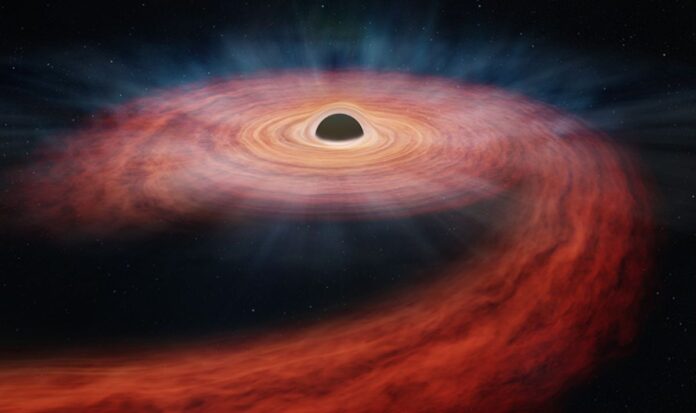Astronomers have been studying a crime scene in space – the remnants of a star torn apart by gravitational forces when it stumbled too close to a deadly black hole. This kind of destruction is known as a ‘tidal disruption event’, for it is a deeply exaggerated version of the effect that allows the Moon’s gravity to produce tides in Earth’ ocean. The black hole’s devastating influence tossed some of the star’s innards away into space, with scientists giving the resulting light show an appropriately ‘killer’ name – ASASSN-14li. ASASSN-14li was first spotted back in late 2014, and at the time was the closest tidal disruption event to Earth discovered in a decade, at just 290 million light-years away. This proximity has allowed scientists to use NASA’s Chandra X-ray observatory and the European Space Agency’s XMM-Newton space telescope to study the entrails of the dead star in extraordinary detail. Astronomers have been studying a ‘crime’ in space – a star torn apart by a black hole (Image: NASA / CXC / M.Weiss) The study was undertaken by astronomer Professor Jon Miller of the University of Michigan and his colleagues. Drawing parallels between their work and the analysis of a crime scene, Prof. Miller said: ‘We are seeing the guts of what used to be a star. ‘The elements left behind are clues we can follow to figure out what sort of star met its demise.’ Specifically, the team analyzed the carbon and nitrogen created by the star before it was shredded by the black hole. Scientists used NASA’s Chandra X-ray observatory to study ASASSN-14li (Image: NASA) The team analyzed the carbon and nitrogen created by the star before it was torn apart (Image: NASA / CXC / University of Michigan / J. Miller et al.) Paper co-author Dr Brenna Mockler is an astrophysicist at Carnegie Observatories and the University of California, Los Angeles. She said: ‘These X-ray telescopes can be used as forensic tools in space. The relative amount of nitrogen to carbon that we found points to material from the interior of a doomed star weighing about three times the mass of the Sun.’ This means that the star destroyed to produce the ASASSN-14li event is one of – if not the – most massive astronomers have seen involved in a tidal disruption event to date. (Earlier this year, a team of astronomers led from Indiana’s Purdue University reported the so-called ‘Scary Barbie’ event where they reported that a star some 14 times the mass of the Sun had been destroyed during an encounter with a black hole. However, this event has yet to be confirmed as a tidal disruption, with the estimate of the star’s mass being principally derived from the brightness of the flare, and not a detailed analysis of the material around the black hole, as in the case of ASASSN-14li.) Black holes are regions of spacetime deformed by concentrated mass (Image: Daily Express US) Astrophysicist Professor Enrico Ramirez-Ruiz of the University of California, Santa Cruz said: ‘ASASSN-14li is exciting because one of the hardest things with tidal disruptions is being able to measure the mass of the unlucky star, as we have done here. ‘Observing the destruction of a massive star by a supermassive black hole is spellbinding because more massive stars are expected to be significantly less common than lower-mass stars.’ The researchers also said that ‘another exciting aspect’ of the ASASSN-14li result is its implications for studies of the hearts of other galaxies. Here in the Milky Way, moderately massive stars like the one destroyed during ASASSN-14li have been seen in the star cluster that surrounds Sagittarius A*, the supermassive black hole that lies at the center of our galaxy. The ability to estimate the mass of tidally disrupted stars could, therefore, give astronomers a tool to study star clusters around supermassive black holes in more distant galaxies. The full findings of the study were published in The Astrophysical Journal Letters . Follow our social media accounts on https://www.facebook.com/ExpressUSNews and @ExpressUSNews
NASA captures giant black hole killing a massive star in incredible new image
Sourceexpress.co.uk
RELATED ARTICLES


